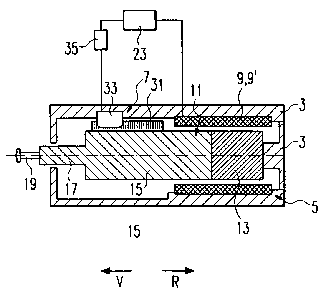Some of the information on this Web page has been provided by external sources. The Government of Canada is not responsible for the accuracy, reliability or currency of the information supplied by external sources. Users wishing to rely upon this information should consult directly with the source of the information. Content provided by external sources is not subject to official languages, privacy and accessibility requirements.
Any discrepancies in the text and image of the Claims and Abstract are due to differing posting times. Text of the Claims and Abstract are posted:
| (12) Patent: | (11) CA 2408257 |
|---|---|
| (54) English Title: | STUD WELDING HEAD |
| (54) French Title: | TETE DE SOUDAGE DE GOUJONS |
| Status: | Term Expired - Post Grant Beyond Limit |
| (51) International Patent Classification (IPC): |
|
|---|---|
| (72) Inventors : |
|
| (73) Owners : |
|
| (71) Applicants : |
|
| (74) Agent: | GOWLING WLG (CANADA) LLP |
| (74) Associate agent: | |
| (45) Issued: | 2010-06-29 |
| (86) PCT Filing Date: | 2001-02-21 |
| (87) Open to Public Inspection: | 2001-08-30 |
| Examination requested: | 2006-01-17 |
| Availability of licence: | N/A |
| Dedicated to the Public: | N/A |
| (25) Language of filing: | English |
| Patent Cooperation Treaty (PCT): | Yes |
|---|---|
| (86) PCT Filing Number: | PCT/DE2001/000683 |
| (87) International Publication Number: | WO 2001062427 |
| (85) National Entry: | 2002-11-06 |
| (30) Application Priority Data: | ||||||
|---|---|---|---|---|---|---|
|
The invention relates to a stud welding head with a linear drive (5), a
welding pin (11) coupled with said linear drive (5), and a length metering
system (7) that determines the position of the welding pin (11) in the stud
welding head, said length metering system (7) being an electromagnetic length
metering system.
L'invention concerne une tête de soudage de goujons comportant un organe d'entraînement linéaire (5), un axe de soudage (11) accouplé à ce dernier (5), et un système de mesure de longueur (7) électromagnétique qui détermine la position de l'axe de soudage (11) dans la tête de soudage de goujons.
Note: Claims are shown in the official language in which they were submitted.
Note: Descriptions are shown in the official language in which they were submitted.

2024-08-01:As part of the Next Generation Patents (NGP) transition, the Canadian Patents Database (CPD) now contains a more detailed Event History, which replicates the Event Log of our new back-office solution.
Please note that "Inactive:" events refers to events no longer in use in our new back-office solution.
For a clearer understanding of the status of the application/patent presented on this page, the site Disclaimer , as well as the definitions for Patent , Event History , Maintenance Fee and Payment History should be consulted.
| Description | Date |
|---|---|
| Inactive: COVID 19 Update DDT19/20 Reinstatement Period End Date | 2021-03-13 |
| Inactive: Expired (new Act pat) | 2021-02-22 |
| Letter Sent | 2020-08-31 |
| Inactive: COVID 19 - Deadline extended | 2020-08-19 |
| Inactive: COVID 19 - Deadline extended | 2020-08-06 |
| Letter Sent | 2020-02-21 |
| Common Representative Appointed | 2019-10-30 |
| Common Representative Appointed | 2019-10-30 |
| Letter Sent | 2019-07-22 |
| Inactive: Single transfer | 2019-07-12 |
| Letter Sent | 2019-03-15 |
| Inactive: Single transfer | 2019-03-06 |
| Change of Address or Method of Correspondence Request Received | 2018-01-10 |
| Inactive: Late MF processed | 2012-02-27 |
| Letter Sent | 2012-02-21 |
| Inactive: Late MF processed | 2011-03-08 |
| Letter Sent | 2011-02-21 |
| Grant by Issuance | 2010-06-29 |
| Inactive: Cover page published | 2010-06-28 |
| Pre-grant | 2010-04-19 |
| Inactive: Final fee received | 2010-04-19 |
| Letter Sent | 2010-01-25 |
| Notice of Allowance is Issued | 2010-01-25 |
| Notice of Allowance is Issued | 2010-01-25 |
| Inactive: Approved for allowance (AFA) | 2010-01-21 |
| Amendment Received - Voluntary Amendment | 2009-05-11 |
| Inactive: S.30(2) Rules - Examiner requisition | 2008-11-12 |
| Amendment Received - Voluntary Amendment | 2008-05-06 |
| Inactive: S.30(2) Rules - Examiner requisition | 2007-11-06 |
| Letter Sent | 2006-01-24 |
| All Requirements for Examination Determined Compliant | 2006-01-17 |
| Request for Examination Requirements Determined Compliant | 2006-01-17 |
| Request for Examination Received | 2006-01-17 |
| Letter Sent | 2004-03-04 |
| Inactive: Single transfer | 2003-12-31 |
| Inactive: Courtesy letter - Evidence | 2003-02-11 |
| Inactive: Cover page published | 2003-02-10 |
| Inactive: First IPC assigned | 2003-02-05 |
| Inactive: Notice - National entry - No RFE | 2003-02-05 |
| Application Received - PCT | 2002-12-03 |
| National Entry Requirements Determined Compliant | 2002-11-06 |
| National Entry Requirements Determined Compliant | 2002-11-06 |
| Application Published (Open to Public Inspection) | 2001-08-30 |
There is no abandonment history.
The last payment was received on 2010-02-22
Note : If the full payment has not been received on or before the date indicated, a further fee may be required which may be one of the following
Please refer to the CIPO Patent Fees web page to see all current fee amounts.
Note: Records showing the ownership history in alphabetical order.
| Current Owners on Record |
|---|
| AVISTUD GMBH |
| Past Owners on Record |
|---|
| JURGEN MADSAK |
| ULRICH CITRICH |